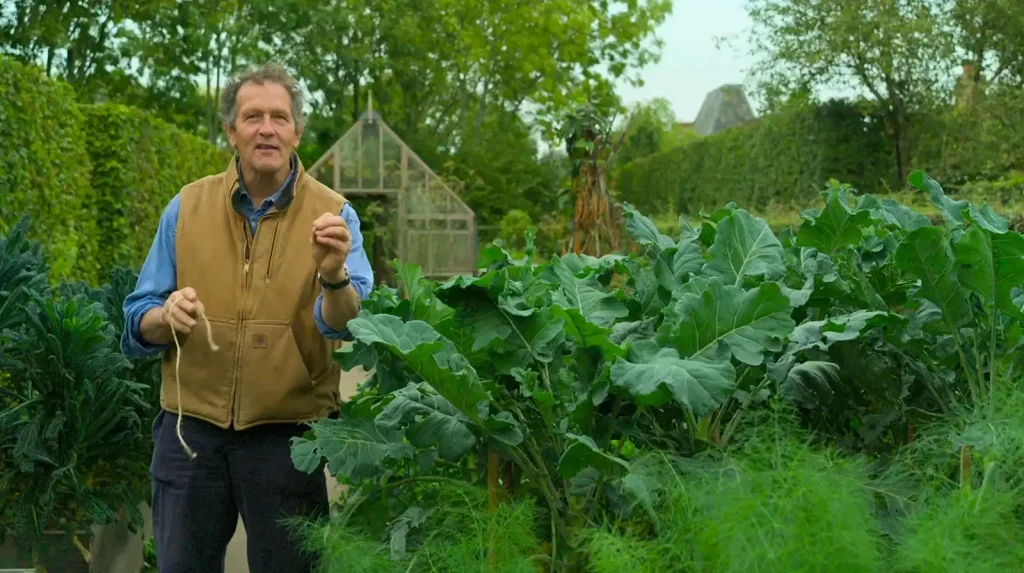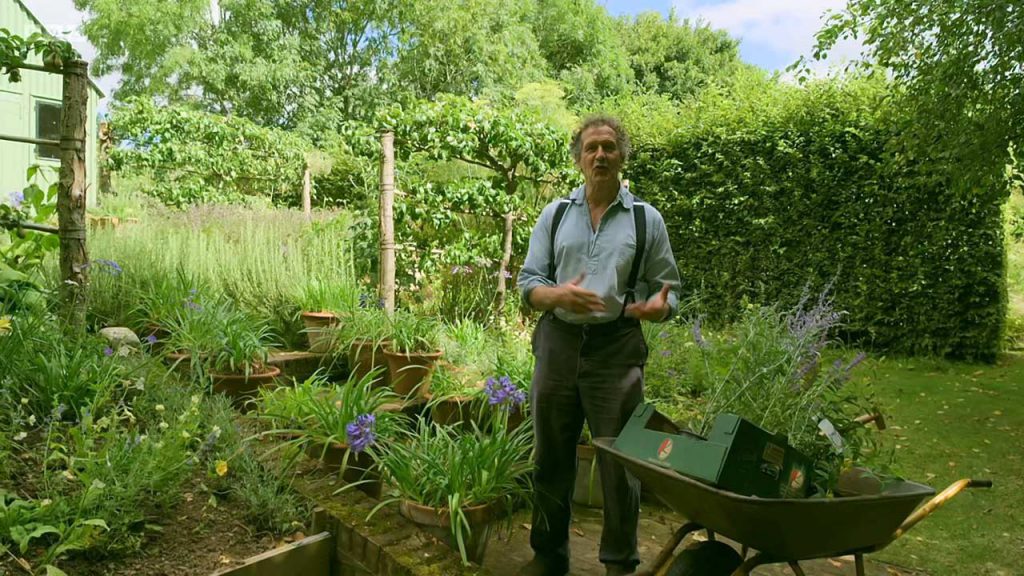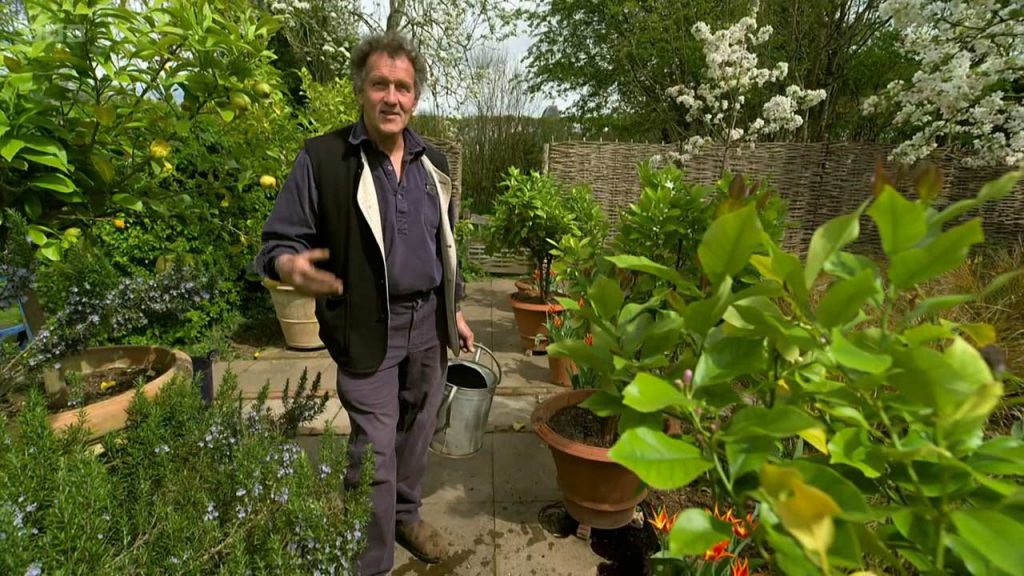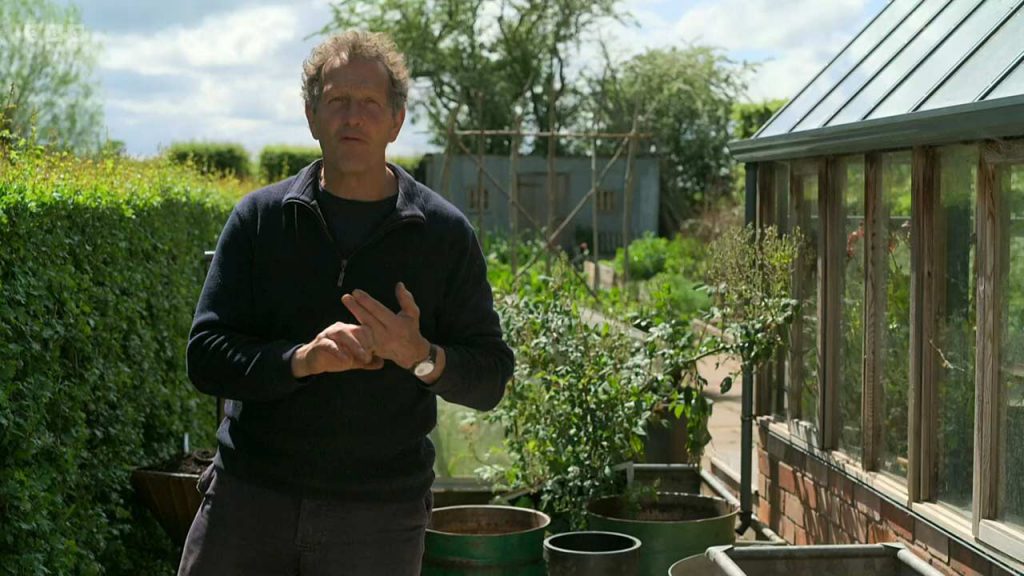Gardeners World 2023 Episode 30 – In the tranquil space of his Dry Garden, Monty Don meticulously uproots his bearded iris plants to give them a new home, ensuring their vitality for the seasons to come. While he’s at it, he takes the opportunity to declutter the greenhouse, preparing it as the ideal environment for nurturing winter salad crops. But that’s not all; Monty has a bounty of quince fruits ready for harvest, adding a touch of sweet and tart flavors to his seasonal recipes. Monty’s ongoing Cottage Garden transformation isn’t just about flowers and produce; it extends to other parts of the green sanctuary as well. This week, he focuses on relocating a well-established shrub to a new spot in the orchard, demonstrating the art of transplanting mature plants without shocking their system. He also shares invaluable tips on how any gardener can save a good chunk of money by collecting and storing seeds from their existing plants, a practice that is both eco-friendly and economical.
While Monty is busy with his gardening ventures, Arit Anderson delves into a hotly debated topic in the world of landscaping: the pros and cons of artificial grass. She examines the arguments from various angles, considering both the environmental implications and the convenience factors that come into play when choosing between natural and synthetic lawns. Journeying beyond the English borders, Toby Buckland finds himself immersed in the serenity of a Japanese-themed garden, ensconced in the picturesque Welsh countryside. The garden serves as a peaceful retreat, blending the traditional elements of Japanese design with the natural beauty of Wales, creating a fusion that captivates every visitor.
We also pay a visit to the charming garden of Andrew Clifton, located in the heart of Nottingham. What sets Andrew’s garden apart is his knack for repurposing and recycling a diverse range of materials, transforming them into elements of a ‘secret garden’ that not only pleases the eye but is also sustainable in its approach. Lastly, meet Steve Edney and Louise Dowle, two devoted gardeners who have skillfully designed an entire border of plants specifically structured to create an awe-inspiring winter scene. What’s more, these plants serve a dual purpose: not only do they transform the garden into a winter wonderland, but they also provide an annual harvest of new seeds, ensuring a continual cycle of beauty and growth.
From garden revamps to ethical debates and inspiring designs, this week’s features offer a rich tapestry of horticultural insights and stories that aim to inform, engage, and inspire every gardening enthusiast out there.
Gardeners World 2023 Episode 30 – A Guide to the Latest Gardening Insights
Monty Don starts this week’s episode with handy tips for transplanting bearded iris, clearing the greenhouse, and harvesting quince. As part of his ongoing Cottage Garden revamp, he moves a shrub to the orchard and shares money-saving seed collection and storage advice. Meanwhile, Arit Anderson weighs the pros and cons of artificial grass – an increasingly popular choice for today’s time-poor gardeners. And Toby Buckland makes a wonderful discovery on his travels – a peaceful Japanese paradise nestled in the lush Welsh countryside.
Revitalizing a Tired Cottage Garden
Many gardeners dream of creating their own slice of cottage garden paradise. Overflowing with informal flowerbeds, rambling roses, and old-fashioned flowering plants, these quintessentially English gardens represent an idyllic, romantic image of the past. However, keeping a cottage garden looking its best year after year can be quite a challenge. Soil becomes depleted, plants become overgrown, and the overall effect can end up looking messy rather than magazine-worthy.
Monty Don is no stranger to the trials of maintaining a large cottage garden. His famous garden surrounding Longmeadow Cottage represents one of the finest examples of the cottage garden style. However, even this garden needs revitalizing from time to time. Recently, Monty has embarked upon a major rejuvenation project to get his tired cottage garden looking tip-top again.
In this week’s episode, Monty demonstrates two key jobs that are part of his overall revival plan. First, he lifts and divides congested bearded iris plants in the Dry Garden. Bearded iris can become overcrowded after a few years in the same position, flower less prolifically, and may even die out in the center. Carefully lifting and replanting sections of iris rhizomes in freshly prepared soil gives them the resources they need to grow and bloom their best again. Monty’s expert hands make short work of replanting the bearded iris. With such TLC, they are sure to reward him with a dazzling display of flowers next spring.
Later in the program, Monty tackles another rejuvenating task – transplanting an overgrown shrub from the Cottage Garden to the orchard. As many gardeners discover, shrubs often outgrow their original planting sites. Moving shrubs to give them more space prevents them from impinging on other plants. Monty’s choice to relocate this shrub also serves a design purpose. Removing the shrub helps open up and remodel a tired corner of the garden, supporting Monty’s overall revamp. With decades of horticultural knowledge, Monty knows just how to transplant mature shrubs successfully. Gently teasing out the roots before replanting prevents damage and gets the shrub off to a vigorous start in its new home.
For gardeners seeking to overhaul their own tired cottage gardens, Monty’s rejuvenation tips are invaluable. Careful relocation of overgrown plants, division of congested perennials, and detailed soil enrichment helps transform drab areas into blossoming flowerbeds. Approached with care and horticultural know-how, reworking mature cottage gardens allows them to regain their former charm.
Clearing the Greenhouse for Productive Winter Growing
As autumn approaches, many gardeners start dreaming of winding down for the year. Not Monty Don! In this episode, he demonstrates how to keep the greenhouse productive all winter long. Cool-season crops actually grow better in the greenhouse during winter. The shelter allows gardeners to harvest fresh salads, herbs, greens, and more when the bare garden outdoors offers slim pickings. Converting the greenhouse from summer to winter growing does take some work however. Monty shows how to clear out the old summer plants to make way for the new winter residents.
First, Monty clips back the dangling vines and rampant growth left over from the summer season. Tomatoes, cucumbers, and beans may still be producing, but their time is up. Removing them stops diseases from overwintering in the greenhouse. Next, Monty thoroughly clears and disinfects the greenhouse benches. Sweeping away old compost and hosing down with a bleach solution destroys lingering pests and diseases. With the greenhouse blank slate ready, Monty begins sowing and planting trays of tasty winter crops. Cool weather favorites like salad greens, spinach, kale, and herbs will thrive in the protected environment of the greenhouse. Successive sowing ensures a constant supply of produce throughout the winter. Interplanting fast and slow growing crops makes the most of every bit of space as well.
For gardeners without greenhouses, Monty’s winter growing tips still apply. Mini hoop tunnels, cold frames, and cloches allow extending the harvest into winter. And winter gardens don’t have to be all about food. Monty advocates planting winter blooming flowers like primroses too, bringing color to dreary days.
The effort spent clearing and replanting the greenhouse will reward Monty all winter long. Baskets overflowing with fresh salads and herbs will garnish meals at Longmeadow Cottage. And tending the greenhouse garden provides happy activity during the shorter, colder days ahead. Monty’s advice and demonstration takes the mystery out of winter greenhouse growing, inspiring us all to keep planting well into the cold months.
Saving Money Through Seed Collecting and Storing
Gardening can be an expensive hobby. The cost of plants, tools, fertilizers and more really adds up. In this episode, Monty Don shares tips for saving money through collecting and storing seeds. This traditional, self-sufficient skill allows gardeners to stock up on seeds for free!
During garden maintenance, Monty points out how easy it is to gather mature seed pods, heads, and canes containing next year’s seeds. From flowers like poppies and cosmos to herbs, vegetables, and more, seed collecting opportunities abound. A quick session wandering the cottage garden with a trug yields bountiful potential. Selecting only the best formed seeds from the healthiest plants ensures quality. Dried and labeled envelopes of collected seeds can be stored in a cool, dry place to use next growing season. Besides the monetary savings, seed collecting and saving allows gardeners to preserve beloved plant varieties and cultivars. Heirloom seeds handed down through generations can be propagated indefinitely. Gardeners can also select seeds from the best performing plants tailored to their growing conditions. And collecting unusual plant varieties from other gardens allows expanding the home landscape.
However, Monty does sound a note of caution about seed collecting. Many hybrid plants will not breed true from their parent’s seeds. And some plants require special treatment like cold stratification before germinating. Always research a plant’s reproductive methods before relying on collected seeds. For open-pollinated, non-hybrid plants, seed collecting represents a time-honored tradition. Just like gardeners of old, modern gardeners can save money and enjoy self-sufficiency through harvesting and storing seeds from their gardens. Follow Monty’s tips to stock up on an array of flowers, herbs, and vegetables grown for free from collected seeds.
The Pros and Cons of Artificial Grass
Low maintenance, evergreen lawns have become increasingly popular. But are artificial grass solutions right for every garden? This episode sees Arit Anderson thoughtfully explore the benefits and drawbacks of this controversial product. On the pro side, artificial turf needs no regular mowing, watering, or feeding required by natural lawns. Once installed properly, fake grass provides an instant “lawn” of even color and texture year-round. For time-pressed homeowners or areas hard to grow grass, artificial turf offers a simple solution. Physically, most mimic real grass quite convincingly these days. Gone are the bright green or shag pile looks of yore.
However, critics argue artificial lawns have downsides too. Lacking mowing or feeding means no grass cycling back nutrients on site. Artificial lawns also contribute to plastic pollution; most are made from non-biodegradable polyethylene. They offer no environmental benefits for soil, water drainage, or wildlife that living lawns provide. Excessive heat absorption is another issue, potentially raising temperatures in urban areas.
Of course, living lawns aren’t perfect either. Traditional turf grasses demand inputs like fertilizers and irrigation that can pollute waterways. Constant mowing consumes fossil fuels and releases emissions. And heavily manicured lawns offer less ecological benefits than meadow environments. So what is the best solution? For many homeowners, a mixed approach may work well. Keep small areas of artificial turf for play and entertainment spaces. Use alternative lawn solutions like microclover in low traffic zones. And devote larger areas to biodiverse, low input meadows rather than high maintenance turf. Weighing up all the variables helps make informed choices balancing priorities like convenience, aesthetics, costs, and environmental impacts.
Arit concludes that artificial turf has a role to play in some gardens. But there are also excellent alternatives to consider that better support nature. Her thoughtful analysis shows that evaluating multiple factors leads to the best outcome. This considered approach can guide all gardeners facing lawn and garden care decisions.
Discovering a Peaceful Japanese Garden Paradise
Leaving routine garden chores behind, Toby Buckland embarks on an inspirational garden visiting adventure. His journey leads to a surprising discovery deep in the Welsh countryside – a masterfully designed Japanese garden.
Tucked into a tranquil valley, this garden offers a portal into a faraway land within Wales. Cherry trees, bonsai, and a serene pond with cascading waterfall evoke the essence of Japan. Yet the borrowed view of the surrounding hills keeps the garden’s beautiful setting ever-present too. It is a skillful fusion of two aesthetics and cultures.
The Japanese garden’s thoughtful design maximizes its mood of peaceful contemplation. Carefully placed stone pathways draw visitors on a meandering journey of discovery. Mass plantings of Japanese forest grasses filter the views and create soft screens. An arched moon bridge invites crossing the water to a quiet bench overlooking the cascade. Seeing this dreamy refuge, Toby comments it is hard to believe such an oasis exists so close to home.
But the Japanese garden also connects back to Wales. The hemlock, pines, and mosses thriving in its cool, shady dell suit the wet Welsh climate. The borrowed views of rolling green hills keep the location rooted in place. While transporting visitors to Japan in spirit, the garden remains harmonious with its Welsh countryside setting.
Toby’s armchair ‘visit’ to this garden is a breath of fresh air. It reminds us to value not just the plants in a garden, but the overall sensory experience created. A beautiful garden can be found even in an unexpected place. Seeking out gardens to visit or simply viewing them online restores the spirit, especially during stressful times. Toby’s inspiring discovery encourages us all to continue looking for beauty blooming in the wider world.
Conclusion
This episode of Gardeners’ World offers much practical advice for sprucing up our own growing spaces. Monty’s top tips focus on revitalizing tired gardens and keeping the greenhouse productive in winter. Collecting seeds can help stretch the gardening budget. We’re also prompted to carefully weigh alternatives like artificial grass in the landscape. But the episode concludes on an uplifting note. Seeing Toby’s joy in discovering a breathtaking Japanese paradise garden reminds us of the deep emotional rewards gardening can offer. With knowledgeable guidance from trusted experts like Monty and inspiring garden visits both near and far, we’re motivated to create our own beautiful havens.
Frequently Asked Questions – Gardeners World 2023 Episode 30
What are Monty Don’s top tips for reviving a tired cottage garden?
Monty recommends lifting and dividing overgrown perennials, moving shrubs that have outgrown their space, and improving the soil with organic matter.
How does Monty Don prepare the greenhouse for winter growing?
He clears out old summer plant debris, disinfects benches, and begins sowing trays of winter veggies and herbs.
What are the main pros and cons of installing artificial grass?
Pros are low maintenance and consistent appearance. Cons are lack of environmental benefits, contribution to plastic pollution, and heat absorption.
What makes the Japanese garden discovered by Toby Buckland unique?
It artfully blended Japanese elements like bonsai and a waterfall with the native Welsh setting.
What takeaway message does the episode leave viewers with?
Appreciating the joy gardens can bring us, thanks to the guidance of experts like Monty Don and being inspired by beautiful gardens near and far.




